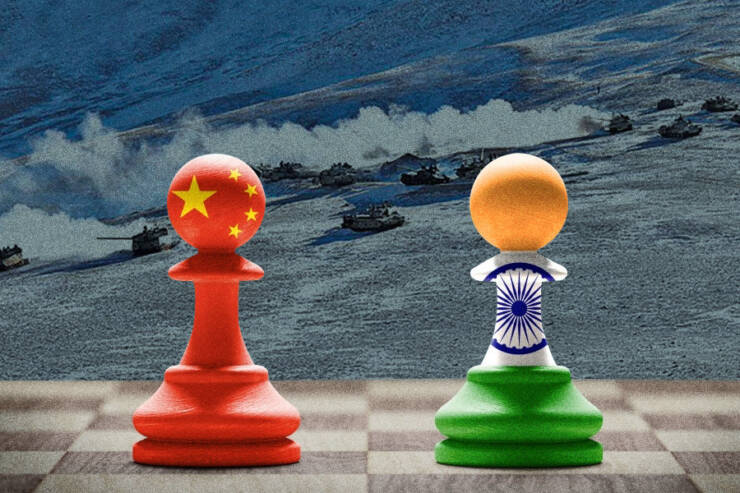
Recently, Beijing and New Delhi agreed that both – Chinese and Indian troops at the southern and northern banks of the Pangong Tso Lake should start “synchronised and organised disengagement”. A breakthrough coming after ten rounds of talks can be savoured as a “road to peace”, but this significant progress should also be used to choreograph a strategy for future.
Deconstructing the Disengagement
China and India have had a history of territorial conflict dating back to 1950s. What’s different this time however, is the stand taken by Indian Army. Instead of playing on back foot, employing an offensive approach by capturing the strategic heights near Pangong Tso Lake and remaining firm on implementing status quo has led to India negotiating as an equal and ultimately reaching a diplomatic resolution with the Dragon.
The present agreement has led to a temporary blockade on patrolling, which was essential. It indeed it reminds of one of the most important lessons in military theories by Clausewitz–political aim must amplify the end state that is sought to be achieved.
However, what does this engagement mean in terms of foreign policy and its practices?
To begin with, this disengagement isn’t a compromise but India’s way of telling the world that even with global contradictions, New Delhi shall stand tall when it comes to national security and territorial integrity.
Apart from this, New Delhi is also nurturing goodwill through vaccine diplomacy by being a world provider- a race where China is currently falling behind us. This is creating a global consciousness of the values countries should abide by to encourage greater contribution to regional geopolitics.
In addition, China’s growing power and the use of accommodative tactics may work for a handful of countries, but New Delhi’s response to the situation was a clear manoeuvre of hurt tactics coupled with geo-economic repercussion which led to the situation we have today. Despite this, one this is very clear after this – New Delhi now needs to turn the crimson tide and most importantly, show act to solve the border agreement for better clarity on the borders.
The Unresolved Border Saga since 1958
There has been a considerable shift in foreign policy and strategic diplomatic posturing – as earlier, New Delhi primarily focused on countering Pakistan, but since the Galwan escalation, there has been a swing to solve the border issues with Beijing, which has been left hanging since 1958. The end game for this negotiation shall be the formalised framework to decide on the border area as China in 1959 claim made to the erstwhile prime minister Jawahar Lal Nehru, but no significant change was implemented.
A Joint Working Group was being made to find the solution for the contested peace on the borders as it’s been recounted by various diplomats involved, but booming trade with Beijing made sure that the negotiation talks remain sidelined. As India shares a 3,488 km-long border with China shows the first order of business if things should go back to normal is to finish deciding on the border agreements. The way Indian administration brought in factors such as Kailash Range – it is clear that New Delhi needs to tactical tricks up its sleeves to tame the “peaceful rise” of the Dragon. As negotiations continue over the Pangong Tso – Gogra, Hot Springs, and Depsang follows, the unsettled border issue with Beijing provides an ample opportunity to coerce New Delhi and keep it engaged instead of focusing on larger issues developing in the Indo-Pacific.
The Way Ahead?
Military Theorist Sun Tzu famously stated: “Supreme excellence doesn’t consist of war; it consists of breaking the enemy resistance even without fighting”. Similarly, this disengagement is nothing but sheer grit and the highest form of generalship synergised with series of diplomatic, military and political will. New Delhi needs to have a coherent China policy for countering future threats as recently it was discovered that Chinese malware targeted Indian Power systems and seaports across India.
India’s role in the Indo-Pacific is consistently nuanced with the national objectives, core interests, foreign policy direction, and achieving desired military results. It is closely observed that Pakistan recently tried to deflect India’s pursuit by having its military exercise with 42 big and small countries – including Russia, China, Turkey, Japan and various other NATO member countries observing and participating in the drills. Apart from these conventional and robust weapon systems, Indian government will have to focus more on technology, space, cyber and other unconventional warfare sorts which are emerging in the rapidly changing means of warfare.
New Delhi gate kept this particular crisis to make many fundamental changes, such as making infrastructure development on the borders a priority. This also serves our national initiative of “Atmanirbhar Bharat” where geo-economy is a major element- the reason which leads to Beijing’s rise in South Asia in the first place. Moreover, engaging with countries such as the EU, UK, France, Canada and Australia – to form a coalition through QUAD and QUAD+ which would not only be democratic allies at hand but important for creating pressure on Beijing, showcasing that New Delhi won’t miss out on a “good crisis” but use it in her advantage.
The current disengagement process has two important takeaways: resolve the border issue and capitalise on the current development but always have something up the sleeves that could turn the crimson tide! New Delhi now showcases grit and posturing, which depicts that Beijing won’t be the only one who shall be making a “peaceful rise” in the Indo-Pacific.
The article was originally published on the web portal of ‘THE PULSE’: https://the-pulse.in/indiachina-disengagement-saga-managing-chinese-aggression-in-a-new-way
-The writer serves as an Assistant Director – Strategy at Alexis Group. He is passionate about law, defence and foreign affairs. He is multi-lingual and has worked with the Ministry of External Affairs (MEA); Centre for Land Warfare Studies (CLAWS); Commonwealth Human Rights Initiative (CHRI) among others. The views expressed are personal and do not necessarily reflect the views of Raksha Anirveda








